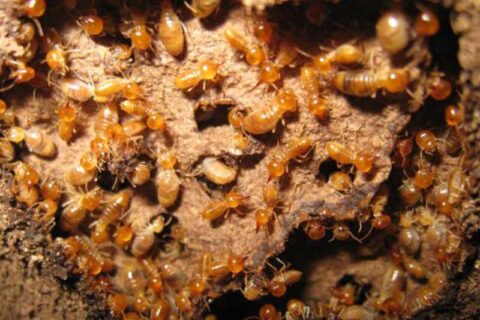Symbiosis Between Termites and Protists
If you were to look into the stomach of a termite under a microscope, you’d see a multitude of small specks moving around. Would you assume those were parasites or bacteria? That’s exactly what was assumed back in 1889 when scientist Joseph Leidy first discovered this activity inside dissected termites. The thing is, he was wrong.
It was a natural assumption, especially in those days, when microscopes were relatively new, and scientists were just learning about bacteria. At that time, many scientists saw all of nature as a battlefield and all microscopic bacteria as dangerous germs. Microbes living in the bodies of animals, then, were assumed to be harmful parasites.
Here’s what we know now: those specks are protists, not bacteria, and they have a symbiotic relationship rather than a parasitic one. The protists, organisms that each consist of just one single, microscopic cell and are not related to animals, bacteria, or fungi, produce enzymes that help termites digest the wood that they eat. This makes more sense to us today than it would have to 19th-century scientists because we know that animals host microbes, many of which are beneficial. Just as we have bacteria in our microbiomes that help with our digestion, termites have these protists.
The termites need the protists because they eat wood containing chemicals that would be otherwise indigestible. With the help of the protists, termites eat something that’s abundantly available but would otherwise be inaccessible. These little microbes in the termite microbiome were recently captured in a video, which required innovative methodology to capture such minuscule beings.
The termite/protist relationship is not the only way termites rely on other organisms to digest their food. The type of termites that use protists as digestion partners is called lower termites. Higher termites evolved after lower termites, and they have a series of cow-like stomachs that house bacteria that help them digest their food. The most recent group of termites, the macro termites, have a more complicated system in place. Rather than eating wood directly, they feed bits of it to a fungus. That fungus breaks down the wood and creates a compost that’s easy for termites to swallow. In their guts, these termites have bacteria that further digest the wood pulp.
Every member of the macro termite colony has this system in place except the queen. The macro termite queen is huge and swollen, and her body has no gut microbes. She’s able to eat, though, because her daughters predigest fluids and regurgitate them into her mouth. In fact, the entire nest is essentially a digestive system for the queen. The walls are laced with fungus, and the queens thousands of daughters attend to her, feeding her food that’s been digested with the help of their billions of gut microbes.
Here’s something especially mind-blowing. The microbes of termites sometimes have their own microbiomes. For example, there’s a species of Australian termite that houses in its gut a protist called Mixotricha paradoxa, a name that means “paradoxical being with mixed-up hairs.” The hairs, in this instance, aren’t hairs at all but bacteria. In fact, this protist carries at least four types of bacteria on and in its body.
If this is hard to comprehend, imagine how much more difficult it was to photograph! And yet, recently, a photomicrographer named Fabian J. Weston won Nikon’s Small World photomicography competition with a video of these protists. Weston, who is from New South Wales, Australia, has long been fascinated with protists. He made this video in the hope that it would bring a greater public awareness of protists and how important they are to our ecosystems. The Small World competition was a great place to unveil, as this competition is Nikon’s annual celebration of microscopic worlds.
Modern microscopes are powerful enough to allow researchers to see things that have long been invisible to the naked eye, like hormones found in the tips of a plant’s roots. Weston used a microscope from the 1970s to create this award-winning film, though. It was extremely complicated, not least because protists are sensitive to light and oxygen. Weston had to figure out how to keep them alive long enough to film them, and it took him several months to come up with an effective solution to his problem. He prepared a saline solution, removing as much gas as he could, and worked very quickly to capture the protists on video. The result is an intriguing, blue-tinged video that seems almost dreamlike. It took months of trial and error, but he eventually produced a video that is truly amazing to watch.
The more we learn about termites and the microorganisms that help them thrive, the more we realize how very complex and interesting these creatures really are. While it’s thrilling to watch microscopic organisms make their way through a termite’s body, though, it’s far less thrilling to find termites on your property. When that happens, it’s time to call for professional assistance to eradicate the termites before they and their microbiome manage to eat their way through your house.
At MightyMite Termite Services, we’ve earned a reputation as experts in California termite control. We perform termite inspections to ensure that your home is free of termites and work hard to help you keep it that way, using treatments that are naturally derived and have a low impact on the environment. We diagnose and treat infestations with the most effective methods and unmatched warranties, solving your termite problems the first time, with an industry-best “no call-back rate.” That, combined with our experience, technology, and highly trained professional staff, makes us the leading extermination company in the Bay Area. We understand that your home is your most important investment, so we work hard to provide excellent service, utilizing best practices to solve our customers’ termite problems in Northern California. For more information, call us today at 408.335.7053, email Info@mightymitetermite.com, or contact us through our website.








